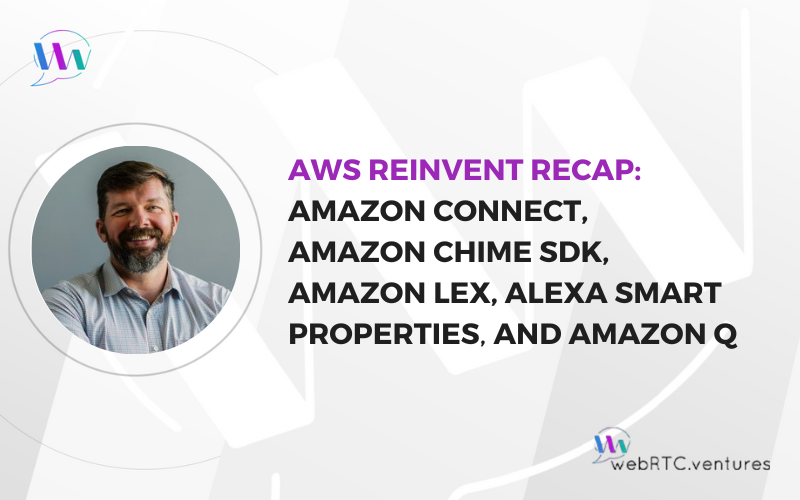AWS re:Invent is always one of the biggest tech conferences of the year. The 2023 edition was no exception. It’s the sort of conference where if you don’t plan the sessions you want to attend in advance and reserve seats, you’ll probably miss out. Many sessions are already full 30 minutes before the start. Combine that with conference locations spread across four major Las Vegas resorts!
I was there for the week going to sessions and meeting with many of our WebRTC.ventures partners also in attendance. It was one of my more intense conference experiences, but I always try to fit in a bit of fun, too. This time I attended a showing of the immersive film, “Postcards from Earth” at Sphere, the incredible new Vegas venue. To see some video from that, as well as hear my commentary from the conference, check out my conference video update below.
In this blog post, I’ll expand on a few key technical and use case topics which I mention in my video above, and provide links for you to learn more. Here are the areas I’ll cover:
- Amazon Connect integration with the Amazon Chime SDK
- Enabling custom Click to Call and In-App calling with the Amazon Chime SDK
- Generative AI, Conversational AI, and Amazon Lex for chatbots
- Voice applications with Alexa Smart Properties
- Generative AI across the AWS ecosystem with Amazon Q
Amazon Connect integration with the Amazon Chime SDK
The Amazon Chime SDK continues to improve in quality. But the big announcement this week was that the video and audio capabilities of the Amazon Chime SDK are now natively supported in Amazon Connect. As System Integration Partners for the Amazon Chime SDK, we’re particularly excited about this evolution.
In the past, it required some extra effort to integrate a ‘click to call’ widget into Amazon Connect. There was also some overlap in the capabilities of Amazon Connect and the Amazon Chime SDK. AWS has now tightened up that integration with the ability to create drop-in code for click to call widgets in JavaScript, iOS, and Android. This makes it much easier to integrate web-based calls and in-app calls from your website or mobile app into your call center.
Don’t worry, the existing Amazon Chime SDK is not changing or going away! All of the APIs and use cases remain the same. The key is there are now APIs for Amazon Connect which wrap some of that functionality and make it easier to integrate and use for Amazon Connect contact center clients.
Enabling custom Click to Call and In-App calling with the Amazon Chime SDK
This new integration is going to work great for many use cases and will help contact centers to further enable their digital transformations. For many use cases, however, a generic click to call widget will not be sufficient. Fortunately, there is still a way to build a custom integration utilizing a lot of the same code.
Perhaps your company’s mobile app has specific workflows or additional context around the customer support interaction that you want to make the best use of. As with any off the shelf or pre-built solution, it may get you 80% of the way there. But that last 20% of functionality could be where the business differentiation value is created.
Consider a telehealth application. Some telehealth use cases might only involve having a video tool built into an EMR and that might work fine for provider-to-provider telehealth. But for patient driven telehealth in specific use cases, a more focused and consumer friendly workflow will be a big advantage.
Take the example of online prescriptions for products around sexual health, weight loss, cannabis, and such. There are companies that have a very focused online workflow that sells and supports their specific product. From an IT perspective, these are really just a call center behind the scenes, taking customer orders and connecting them with specialists when needed. On the consumer side, they look something like an e-commerce workflow, but with required video or audio telehealth visits at specific steps.
Our team at WebRTC.ventures has built completely custom applications for use cases like this in the past. Now we can do that more efficiently and at larger scale by combining the contact center capabilities of Amazon Connect with the Click to Call capabilities of the Amazon Chime SDK.
Generative AI, Conversational AI, and Amazon Lex for chatbots
The Amazon Alexa devices are widely known by consumers. But it takes an AWS expert to know that you can access much of the same conversational AI capabilities of Alexa Skills by building with Amazon Lex. This allows you to build a chatbot via configuration and then expose that via text chat or voice applications.
Like most traditional chatbots, this has traditionally been a very “intent” driven workflow. You have to consider all of the different paths a user might take through the chatbot experience and configure different question and answer paths. Although this is typically done in low-code visual configurations and dashboards, it can still be a lot of work to analyze and maintain all those branches off a chatbot workflow.
With generative AI, this is changing. I attended a presentation that showed where we are headed. Now with Amazon Lex, you can start to configure a bot simply by typing out a paragraph of what you want. You might start your bot creation with something like:
“Build me a customer support chatbot for my hotel which handles placing reservations, changing reservations, and getting information about the hotel.”
By writing a general problem statement like this, the generative AI can set up an initial version of your chatbot in Amazon Lex. While you still need to review and change many parts of it before you go live, this is nonetheless an impressive time saver and a way to help ensure that Lex chatbots are built using best practices.
For example, one of the hassles of chatbot configuration is thinking of synonyms for how a customer might ask a question. A customer might say any of the following, all of which should be responded to in the same way by the chatbot: starting the workflow to change an existing reservation.
- Can I change my reservation?
- Will you help me update my reservation?
- I want to move my stay to another night.
- I’d like to extend my stay.
The generative AI in Amazon Lex is able to pre-populate an impressive list of common questions to start different parts of the workflows. This is a tremendous time saver and shows how generative AI can be incorporated into builder tools like Amazon Lex to improve efficiency.
Voice applications with Alexa Smart Properties
Another interesting presentation was a case study by Atria Senior Living Management. Chris Nall, CTO of Atria, showed us how they used Alexa Smart Properties to manage a large network of Alexa devices across many senior communities to provide voice-based interfaces for their residents. The driving forces were to improve the quality of life of the residents and to assist Atria with handling the staff shortages that are endemic to their industry.
Typical questions a resident might ask, like “What’s for dinner tonight?” can be answered by simply asking the Alexa device. The Alexa devices also list community events going on that day, in order to encourage the seniors to socialize. For more complicated questions or issues, the built-in Alexa calling feature facilitates a call to the community’s concierge.
Voice is a very good interface for seniors. It’s the most natural human interface and doesn’t require learning a specific browser, operating system, or mobile device interface. After the most basic of training on typical questions you can ask Alexa, users will quickly become accustomed to using the device.
As I wrote about after the HIMSS 2023 conference, it’s also now possible to use WebRTC with Alexa devices. This means you can build custom Alexa skills which use WebRTC to connect into traditional telephony and call centers, or perhaps to call out to other phones or custom applications. Although Atria is not doing this yet, their architecture with Alexa Smart Properties leaves open the possibility of custom applications for use cases like telehealth or family and caregiver communication.
Generative AI across the AWS ecosystem with Amazon Q
Of all the AWS re:Invent announcements, the generative AI-powered Amazon Q tool will likely have the greatest impact and certainly generated the biggest hype. AWS keynotes talked about how Amazon Q will impact the full lifecycle of working with AWS, from the engineers constructing a service on AWS to the end users of that service.
For example, Q is integrated into Amazon CodeWhisperer to help developers generate better code and configure AWS services more efficiently. This can cover everything from software development to analyzing network issues and debugging a service. For specific use cases like configuring a chatbot in Amazon Lex using generative AI, Q will figure out an initial set of options for you.
Q has the potential to greatly improve the work of engineers using AWS, which should help us all to deliver higher quality work more efficiently.
Q will impact end users also. Amazon Connect can provide a good example of this: a contact center agent using Amazon Connect will have access to information generated by Q in their agent dashboard, helping them to better resolve customer questions.
We can also look at the impact of generative AI on Amazon Lex and Alexa more broadly. It’s the power of generative AI that helps the chatbot to understand that you need a room for four people when you say, “I need a hotel room for myself, my spouse, and my 2 kids.” This level of complex conversational interaction is not feasible with typical intent-based chatbot configuration. Generative AI can enable it, providing more natural interaction and higher user satisfaction.
What do you want to invent with AWS?
Generative AI is improving rapidly. Yet complex software applications still need to be designed, developed, integrated, tested, deployed, and managed by humans. The speakers at re:Invent made it clear that AWS can help make our work more efficient and unlock new capabilities that we can build into our applications. But it still takes experts to put all the pieces together in a way that provides sustainable business value.
That’s why our team at WebRTC.ventures has invested so much time in becoming members of the Amazon Partner Network, and in being recognized as System Integration partners for the Amazon Chime SDK. We are now able to combine that expertise with Amazon Connect to bring more multimodal communication into the contact center as well. We can even help your team build WebRTC connections into an Alexa skill for unique communication capabilities outside of standard Alexa calls!
No matter what AWS services you are interested in building with, our team’s extensive experience in building communication applications can help you be more successful and get to market more efficiently. Contact us today to learn more and get a quote!











